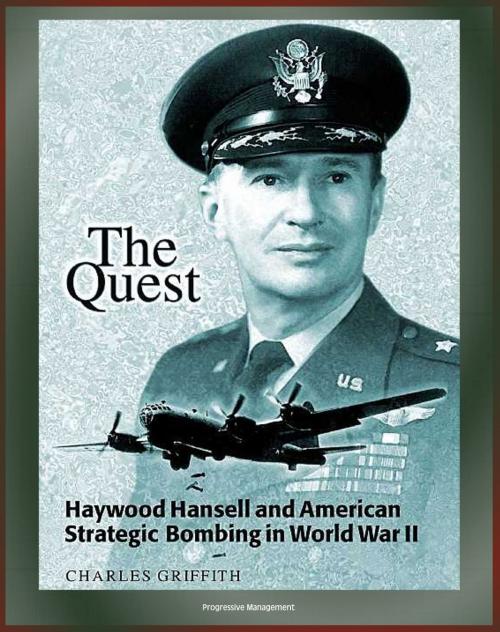The Quest: Haywood Hansell and American Strategic Bombing in World War II - Legendary Airman, Doctrine of Precision Bombing, Incendiary Bombing of Japan
Nonfiction, History, Military, Aviation, World War II| Author: | Progressive Management | ISBN: | 9781476491011 |
| Publisher: | Progressive Management | Publication: | June 9, 2012 |
| Imprint: | Smashwords Edition | Language: | English |
| Author: | Progressive Management |
| ISBN: | 9781476491011 |
| Publisher: | Progressive Management |
| Publication: | June 9, 2012 |
| Imprint: | Smashwords Edition |
| Language: | English |
In his book The Quest: Haywood Hansell and American Strategic Bombing in World War II, Charles Griffith makes a major contribution in detailing the role played by General Hansell from his early days as an instructor at the Air Corps Tactical School to the heady days and nights as a young war planner developing the air war plan used by the United States during World War II to his triumphs and disappointments as a commander in the field. While the book tells this story well, it does more than just relate the life and times of Possum Hansell. The book goes a long way toward explaining the origins of many of the arguments about the utility of airpower in the closing decade of the twentieth century.
The bottom line is Hansell had it right—technology and time have made his vision a reality as evidenced by Desert Storm in 1991, Bosnia in 1995, and most recently in Kosovo. At the heart of his vision was the idea of airpower as a tool for precision engagement, not an indiscriminate weapon of mass destruction. A tool that, if properly understood and employed, would allow the United States to prevail while greatly reducing the price of victory.
Maj Gen Haywood "Possum" Hansell Jr. was a legendary airman from the interwar years and World War II ; he was a gentleman of great intellect who continued throughout his life to be an active student of history, a lecturer, and a spokesman who articulated the advantages of airpower.
Haywood Hansell is arguably the most important proponent and practitioner of high-altitude, daylight precision bombing in the United States Army Air Forces in World War II. Even though his name is not as immediately recognized as the names of Chennault, Spaatz, Doolittle, LeMay, Eaker, or Arnold, Hansell's accomplishments are significant and impressive. He flew as a stunt pilot in the barnstorming days with Claire Chennault. He later attended and taught at the Air Corps Tactical School, where he helped formulate America's prewar air doctrine. He then took a leading role in preparing the three great air war plans (AWPD-1, AWPD-42, and the plan for the Combined Bomber Offensive) for the strategic bombing campaign against Nazi Germany. He commanded the only operational B-17 wing in England from January to June 1943 and had thus directed the first American bombing missions over Germany. Then, at the request of General Arnold, he returned to Washington to create the world's first global striking force, the Twentieth Air Force. As chief of staff of the Twentieth Air Force, Hansell was given virtually a free hand to oversee the early missions of the XX Bomber Command in distant China. Then as commander of the XXI Bomber Command in the Marianas, Hansell overcame many operational difficulties to direct the first B-29 raids over Tokyo and successfully established the basis for the sustained strategic bombing campaign against Japan, which ultimately contributed greatly to the collapse of the Japanese Empire. Hansell was ahead of his time. In view of recent operations carried out against Iraq and Serbia, it is clear that Hansell's vision for American strategic air doctrine was ultimately made possible by advances in technology.
1 THE PROBLEMS OF AIRPOWER; 2 THE EARLY YEARS: EDUCATION AND ACTS; 3 PLANNING; 4 THE FRICTIONS OF WAR; 5 THE GLOBAL BOMBER FORCE; 6 TRIUMPH; 7 TRAGEDY
In his book The Quest: Haywood Hansell and American Strategic Bombing in World War II, Charles Griffith makes a major contribution in detailing the role played by General Hansell from his early days as an instructor at the Air Corps Tactical School to the heady days and nights as a young war planner developing the air war plan used by the United States during World War II to his triumphs and disappointments as a commander in the field. While the book tells this story well, it does more than just relate the life and times of Possum Hansell. The book goes a long way toward explaining the origins of many of the arguments about the utility of airpower in the closing decade of the twentieth century.
The bottom line is Hansell had it right—technology and time have made his vision a reality as evidenced by Desert Storm in 1991, Bosnia in 1995, and most recently in Kosovo. At the heart of his vision was the idea of airpower as a tool for precision engagement, not an indiscriminate weapon of mass destruction. A tool that, if properly understood and employed, would allow the United States to prevail while greatly reducing the price of victory.
Maj Gen Haywood "Possum" Hansell Jr. was a legendary airman from the interwar years and World War II ; he was a gentleman of great intellect who continued throughout his life to be an active student of history, a lecturer, and a spokesman who articulated the advantages of airpower.
Haywood Hansell is arguably the most important proponent and practitioner of high-altitude, daylight precision bombing in the United States Army Air Forces in World War II. Even though his name is not as immediately recognized as the names of Chennault, Spaatz, Doolittle, LeMay, Eaker, or Arnold, Hansell's accomplishments are significant and impressive. He flew as a stunt pilot in the barnstorming days with Claire Chennault. He later attended and taught at the Air Corps Tactical School, where he helped formulate America's prewar air doctrine. He then took a leading role in preparing the three great air war plans (AWPD-1, AWPD-42, and the plan for the Combined Bomber Offensive) for the strategic bombing campaign against Nazi Germany. He commanded the only operational B-17 wing in England from January to June 1943 and had thus directed the first American bombing missions over Germany. Then, at the request of General Arnold, he returned to Washington to create the world's first global striking force, the Twentieth Air Force. As chief of staff of the Twentieth Air Force, Hansell was given virtually a free hand to oversee the early missions of the XX Bomber Command in distant China. Then as commander of the XXI Bomber Command in the Marianas, Hansell overcame many operational difficulties to direct the first B-29 raids over Tokyo and successfully established the basis for the sustained strategic bombing campaign against Japan, which ultimately contributed greatly to the collapse of the Japanese Empire. Hansell was ahead of his time. In view of recent operations carried out against Iraq and Serbia, it is clear that Hansell's vision for American strategic air doctrine was ultimately made possible by advances in technology.
1 THE PROBLEMS OF AIRPOWER; 2 THE EARLY YEARS: EDUCATION AND ACTS; 3 PLANNING; 4 THE FRICTIONS OF WAR; 5 THE GLOBAL BOMBER FORCE; 6 TRIUMPH; 7 TRAGEDY















